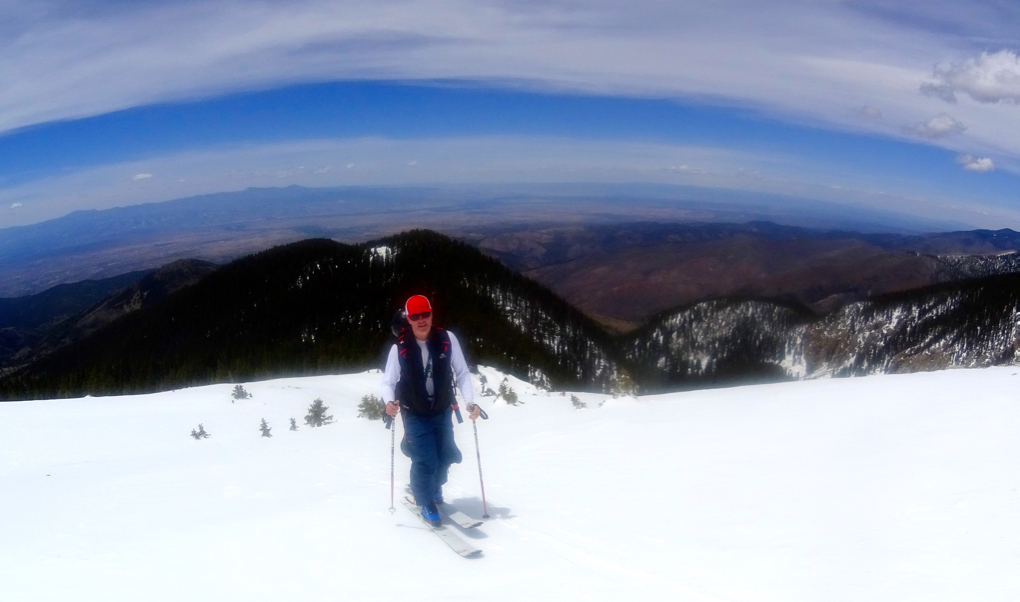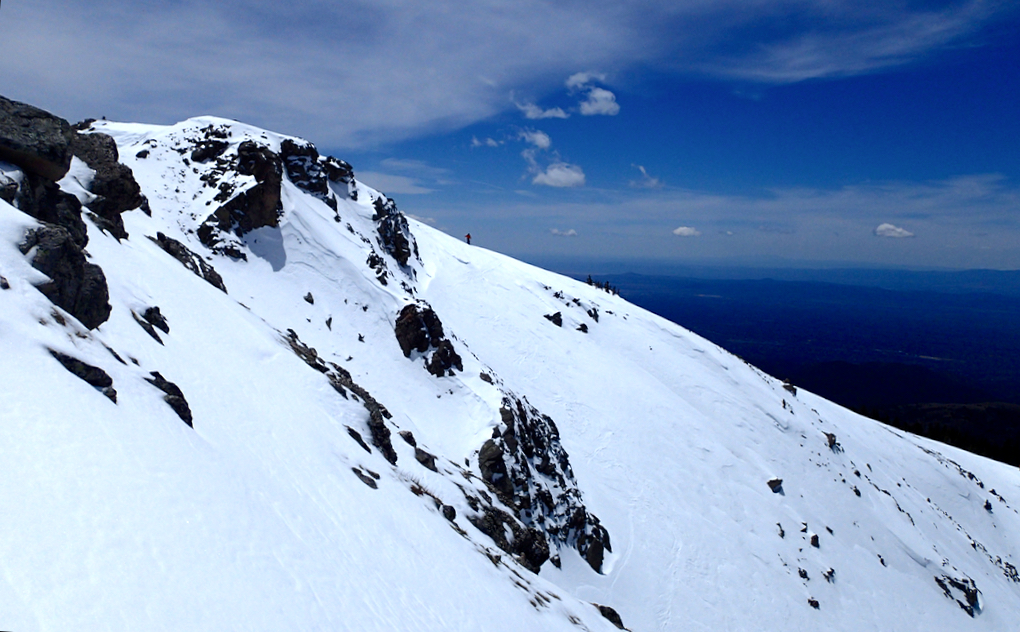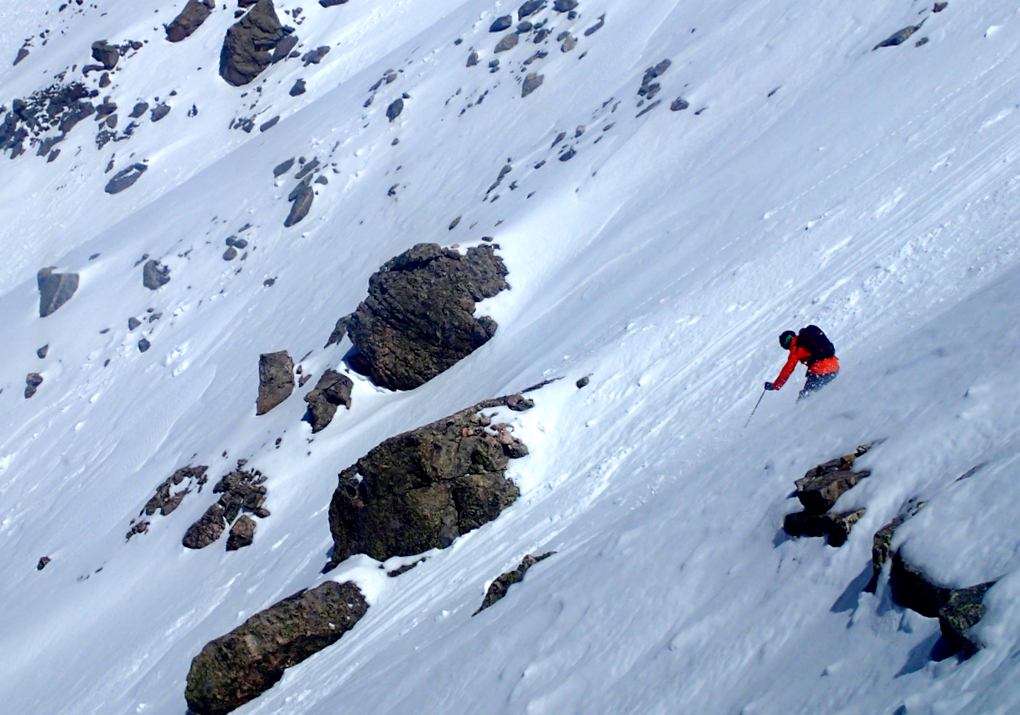
Ski: 2015-2016 G3 Zenoxide, 186 cm
Stated Dimensions (mm): 131-105-123
Blister’s Measured Dimensions (mm): 131.5-104.5-121.5
Actual Tip-to-Tail Length (straight tape pull): 183.6 cm
Blister’s Measured Weight per Ski:
• 1876 & 1890 grams
• with G3 ION 12 demo bindings: 2531 & 2543 grams
Tip / Tail Splay (ski decambered): ~66 mm / ~11 mm
Core: Poplar Paulownia
Factory Recommended Line: -10.7 cm from center; 81.0 cm from tail
Mount Location: Recommended Line
Boots: Salomon Mtn Lab & Fischer Transalp
Binding: G3 Ion 12
Test Locations: Taos & Santa Fe backcountry; Arapahoe Basin
Days Skied: 8
The G3 Zenoxide Carbon Fusion 105 is no joke. It is stiff. And it is great.
If you typically head into the backcountry only when you are confident that the snow will be deep and pretty perfect, there are better skis out there.
But if you are looking for a relatively light ski to go uphill that will also inspire confidence when you get into sketch ball conditions or terrain, then you really ought to keep reading.
Design / Flex Pattern
The dimensions, camber profile, and mount point of the Zenoxide Carbon Fusion 105 are pretty old school. There is a little bit of tip rocker here—what I am inclined to call “just enough.” There are about 4 mm of traditional camber underfoot, and the Zenoxide has no tail rocker—only a slightly twinned-up tail.
Roughly speaking, if you imagine a lightweight, wider-waisted touring version of the 13/14 Volkl Mantra (a favorite ‘bad conditions’ ski of mine), you’d be getting very close to the Zenoxide 105.
And actually, the flex pattern of the 186 cm Zenoxide 105 is similar to—but stiffer than—the 13/14 and current 184 cm Mantra. Compared to the current (15/16) Mantra, the Zenoxide’s tails are noticeably stiffer, and the shovels are very slightly stiffer. I would break the Zenoxide 105 down like this:
Tails: Very Stiff (among the stiffest tails we’ve ever tested. I’d call it a 9 out of 10)
Underfoot: Very Stiff (again)
Tips: Stiff (comparable to the 184 cm Volkl Mantra)
I have argued in the past that it is very possible to make a light ski too stiff and jarring—especially for difficult inbounds conditions (i.e., variable snow and bumped-up terrain). But I have yet to feel that way about the Zenoxide 105. Instead, I have been very pleased with how relatively easy it is to drag this ski uphill given how predictable and stable the ride is when going downhill.
Going Up / Weight
I recently reviewed the 186cm Moment Tallac which is almost exactly the same width underfoot as the G3 Zenoxide 105. The two skis are similar enough that there is little difference in how they perform going uphill.

Our test pair of Zenoxide 105s came mounted with a G3 Ion 12 demo binding, so take away the little bit of extra weight of the demo set up, and the Zenoxide 105 and Tallac would come in at very nearly the same weight.
If you’re breaking trail in very deep snow the deeper tip rocker line of the Tallac might be a little bit of a bonus, but I’d call these two skis pretty much even when it comes to climbing.
Going Down
In rotten, punchy snow, wide skis that are heavily tip and tail rockered work really well. The Zenoxide 105 is not terribly wide and is certainly not rockered out. But if you’re willing to take a fall line approach and ski with some speed—which, by the way, the Zenoxide 105 is most definitely designed to allow you to do—then you’ll be fine.
And I can say from experience that if you happen to encounter a steep, consequential, and bulletproof entrance, you will become very grateful very quickly for the relatively long effective edge of the Zenoxide 105, its camber underfoot, and its minimal tip rocker.
And this is exactly why I have come to like—and trust—the Zenoxide 105 so much: I know exactly what I’m getting out of this ski, which is very reassuring when you’re about to enter steep, sketchy entrances or get surprised by entire lines of crap snow.
And if the snow is deep and / or perfect? Ski fast and fall line, and the Zenoxide 105 will plane. It won’t be nearly as surfy and smeary as a more heavily rockered ski, but you’ll be fine.

(Note: if you are looking for a lighter, more soft-snow oriented ski with a softer flex pattern and a lot more tip and tail rocker than the Zenoxide 105, the 15/16 185 cm G3 Synapse Carbon 109 weighs in at 2222 & 2231 grams with the same G3 Ion 12 demo binding that is on the Zenoxide 105.)
How Damp is the Zenoxide 105?
To me, this is always an important (if tricky) question when it comes to lighter skis. I want to know if a ski is either going to become a floppy noodle at speed, or if it is going to rattle my teeth out of my head in less-than-perfectly-smooth snow.
If this is a tricky question in the case of the Zenoxide 105, it’s because the long effective edge and lack of heavy tip and tail taper are things that contribute to this ski’s predictability and stability. And as I noted in my Tallac review, the subtle tip rocker and traditional mount point allow you to get all over the shovels of these skis and really drive them. Hard. In fact, if you don’t like to drive your skis but prefer a more centered, playful stance, I’m pretty sure that you will get along better with other skis out there.
So is the Zenoxide 105 damp? So far, it’s been damp enough. It’s also been surprisingly, happily predictable and stable.

The G3 Zenoxide Carbon Fusion 105 as a ’50 / 50′ Ski?
I skied the Zenoxide at Arapahoe Basin this spring, mostly just to begin to answer this question about how suitable the Zenoxide 105 is for both inbounds and out of bounds duty.
The big asterisk here is that the conditions were pretty slushy, so there was a lot of built-in natural suspension in the snow. And there’s no question that slush (or deeper pow) is a favorable condition for a lightweight, stiff ski.
But as someone who detests the idea of banging out resort laps on AT equipment, I have to say that the Zenoxide 105 performed quite well—even with the G3 Ion 12 binding and the Salomon MTN Lab AT boots. The snow was a little too wet and soft to permit high angulation carves (the snow would tend to just give way), but in terms of the Zenoxide 105’s all mountain performance, performance in bumps, and big-turn stability at high speeds, I honestly wasn’t missing my typical alpine equipment.
All that’s to say, if this flex pattern sounds like it would work for you, the Zenoxide 105 is a ski that I could recommend easily for use inbounds and out, which I consider high praise and a tall order for any ski to fill.
Bottom Line
The G3 Zenoxide Carbon Fusion 105 is not a ‘fun’ ski, it’s a serious ski that makes bad backcountry conditions and consequential lines more fun.
The Zenoxide 105 is a light enough ski that advanced and expert skiers won’t have trouble making it work when the conditions are good, and there is currently no touring ski I’d rather be on when the conditions are less than good.
NEXT: Rocker Profile Pics

Got a chance to demo both the 167 G3 Carbon Zenoxide and the 185cm G3 Empire Carbon 115 skis on two separate backcountry days in steep to moderate angled chutes. Both were ‘one and done’ runs at the end of May and early June so, very limited reviews. Boot sole center was about 1cm forward of the line on both skis and edges were sharp tip to tail. Dynafit Mercury boots, no tongue; G3 Ion rental/demo bindings.
Carbon Zenoxide: Snow was soft sun dimpled on moderately angled open slope transitioning to smooth somewhat more classic corn in a steeper chute to 45 degrees then to deeper soft suncups for the moderately angled runout. Initial concerns about lack of length for the skis proved to be unfounded…167cms are probably the shortest ski I’ve been on since high school but felt substantial enough for the conditions. Echoing the general ski feel of your comments; the skis liked to be driven from the tip but with the shorter length, could be enjoyably worked through the middle and finally through the tail to carve medium radius turns in the moderately angled start of the run. Dropping into the chute proper, tight hop turns from a centered position felt balanced and feeling the solidity of the ski, encouraged opening up the radius and charging some g.s. turns down the belly of the upper part of the widening chute. The skis remained solid, predictable and damp as speeds were cranked up…still encouraged tip initiated turns but the tails felt great to really push into to either complete the turn or release into speed shaving slarves. Pretty amazed to feel this confidence on skis severely lacking in running length. Once the more schmooey snow for lower third of the run was reached, turn radius was tightened to short skidded z’s. Nothing funky to report…skis provided a firm platform and allowed for consistent confident mank cranking. I would consider this ski as a special purpose little shorty for “2D snow with a solid or progressive base” spring/summer projects or winter inbounds groomers…I kinda felt a longer length would be a bit too stiff for my preferences in a more versatile performer in varied snow conditions.
Empire Carbon 115: Snow was firm transitioning to slightly sun softened sun dimples and sun cups. Some pretty steep hard snow to upper 40 degrees slowly transitioning to more moderately angled terrain below. Only took me two turns to find the sweet spot for harder snow on pretty committing terrain; centered or ever so slightly aft of center. Forward weighting in steeps would result in slight ski overturn, centered to aft of center felt solid. Minimal chatter, felt pretty damp in firm but not frozen suncups. Easy pivoting and slarvy skidded short and medium radius turns. Lower angle wide open terrain high speed big turn carving on suncups proved enjoyable; these babies railed; damp, torsionally stiff and had a solid tail. Could employ just a bit more shin/tongue pressure turn initiation through the big carves. In general, a highlight was the impressive underfoot/heel pressured turn edge feel for a 115mm waisted ski. Can’t wait to try ’em in winter snow of all sorts.
gopro footage of the Empire 115 run here: https://vimeo.com/130351878
Really appreciate the feedback, Swissiphic. Good stuff.
The Blizzard Zero G 108 185cm is another very impressive light but agile and damp BC charger.
Semi-interesting non-note: I have skied the Zero G 108, but *only* on 3-4 runs at Taos, on alpine bindings, on pretty firm snow. So my opinion here really isn’t relevant (which is pretty funny, given that most ski magazine tests don’t put even this much time on a pair of skis…). But at no point while skiing the Zenoxides did I think of the Zero G 108. I don’t know the weight of the 185cm Zero G, but given my limited experience on them at Taos, my initial sense is that I would have preferred to be on the Zenoxide in the same conditions. So not quite ready to assume that the Zero G is as damp as the Zenoxide 105, but I do hope to get more time on the Zero G.
On paper they seem like similar skis. I had a very enjoyable few runs demoing a pair of Zero G’s with Kingpins at Kicking Horse in pow, blue ice and everything in between. I did my best to get them out of their comfort zone, something I tend to be fairly good at and I was impressed, particularly when they were on edge. Would you say that the Zenoxide is a damper, more stable ski given your limited observations?
So, when do we get the MTN Lab boot review…
interesting. your comment on this being the ski for crappy snow conditions is what I say about my carbon katana s.
how would YOU compare them?
First, the Zenoxide vs. the V-Werks Katana is very apples-to-oranges. In my review, I compare the Zenoxide to a touring version of the Volkl Mantra, so it’s quite a bit like asking how you’d compare the Mantra to the Katana — quite different skis, right?
As I reported in my review of the 184 V-Werks Katana, that ski floats extremely well, so is the MUCH better tool for deep snow skiing. (Duh.) And in very punchy snow, the wider + tip & tail rockered Katana would probably work better.
But on firm steeps — or bulletproof to very steep steeps? I’ll easily take the Zenoxide 105 over the Katana — as I would easily take the Mantra over the Katana in such terrain / conditions.
Does anyone know how the ski has changed from last year, besides the topsheet?
My understanding is that it hasn’t – just the topsheets.
Thanks for another fantastic review, Jonathan!
I’ve been on skis for nearly 30 years, but just starting to get into AT, and need to figure out a setup for this season. I do have a side country setup (Dukes + Bibbys), but I’m mostly in the dark when it comes to choosing equipment for a full day of climbing. I’ll be spending a lot of time touring in the Northeast (NY, VT, Tuckerman) and anticipate my season culminating in something like the Haute Route.
Is the Fusion 105 the ski to rule them all? I read the reviews of the DPS 112’s and sounds like they get squirrely in less than ideal conditions. Leaves me a little nervous considering something like the Haute Route is in my future. Not to mention, snowfall in the Northeast is usually shallow and variable (this last season is hardly an accurate representation). I also travel a few times a season to areas with more snow – Colorado, Utah, Japan, wherever – but I wouldn’t say these trips will constitute most of the use of my AT gear. Just mentioning bc I still want some float to whatever skis I end up with.
Anything that strikes you as the perfect fit?
As for me: 5’11”, 160lbs, aggressive expert (downhill), slothlike beginner (uphill).
What about the Zenoxide cf 88? Does it have the same flex pattern as the 105 (only with a narrower waist)?